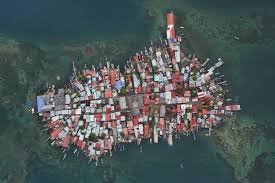On a tiny island off Panama’s Caribbean coast, about 300 families are packing their belongings in preparation for a dramatic change. Generations of Gunas who have grown up on Gardi Sugdub in a life dedicated to the sea and tourism will trade that next week for the mainland’s solid ground.
The Gunas of Gardi Sugdub are the first of 63 communities along Panama’s Caribbean and Pacific coasts that government officials and scientists expect to be forced to relocate by rising sea levels in the coming decades.
On a recent day, the island’s Indigenous residents rowed or sputtered off with outboard motors to fish. Children, some in uniforms and others in the colorful local textiles called “molas,” chattered as they hustled through the warren of narrow dirt streets on their way to school.
“We’re a little sad, because we’re going to leave behind the homes we’ve known all our lives, the relationship with the sea, where we fish, where we bathe and where the tourists come, but the sea is sinking the island little by little,” said Nadín Morales, 24, who prepared to move with her mother, uncle and boyfriend.Gardi Sugdub is one of about 50 populated islands in the archipelago of the Guna Yala territory. It is only about 400 yards (366 meters) long and 150 yards (137 meters) wide. From above, it’s roughly a prickly oval surrounded by dozens of short docks where residents tie up their boats.
Every year, especially when the strong winds whip up the sea in November and December, water fills the streets and enters the homes. Climate change isn’t only leading to a rise in sea levels, but it’s also warming oceans and thereby powering stronger storms.
The Gunas have tried to reinforce the island’s edge with rocks, pilings and coral, but seawater keeps coming.
“Lately, I’ve seen that climate change has had a major impact,” Morales said. “Now the tide comes to a level it didn’t before, and the heat is unbearable.”

